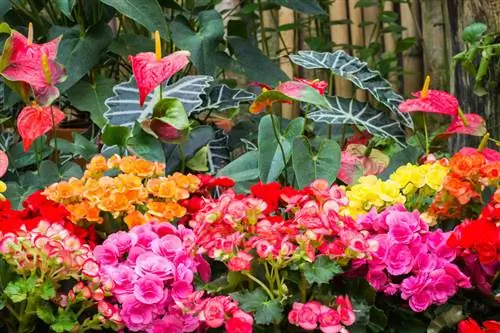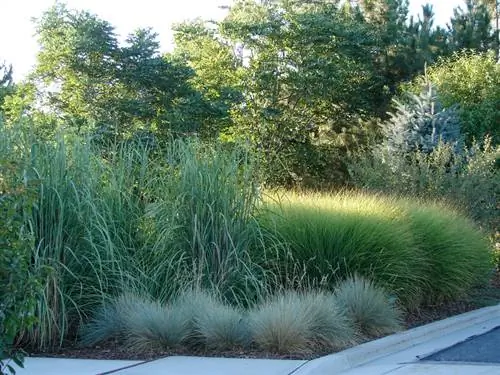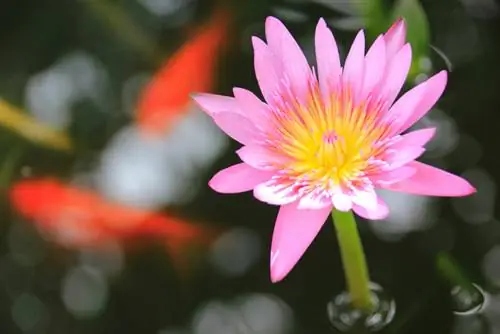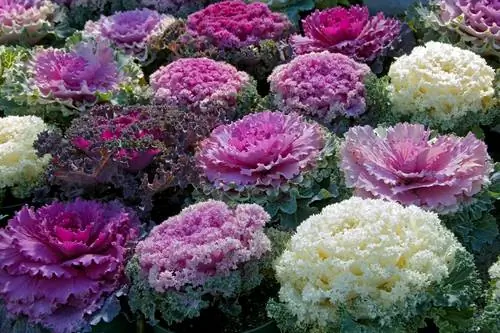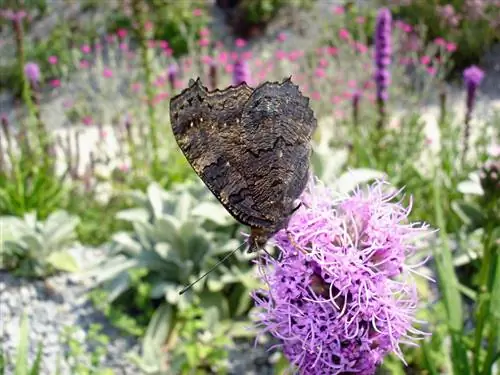- Author admin [email protected].
- Public 2023-12-25 17:45.
- Last modified 2025-01-23 11:20.
With its natural charm, the maiden in the countryside adorns the rustic cottage garden, summer flower borders and beautifully rounds off rustic dry bouquets. The annual flower with the delicate wreath of blue, pink or white flowers is experiencing a much-noticed renaissance. Find out how easy cultivation is with well-founded answers to frequently asked questions.
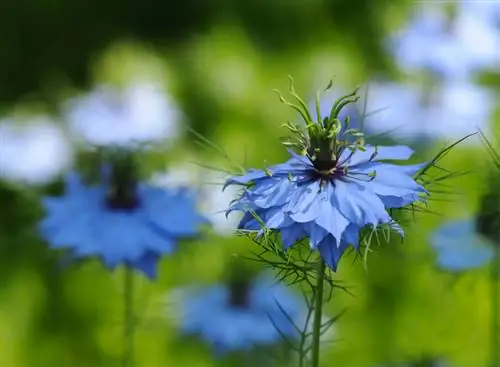
How do I care for the maiden in the green plant?
The maiden in the green requires a sunny location, fresh and humus-rich soil, as well as occasional watering in dry conditions. Fertilizing is not necessary in the bed; in potted plants, add liquid fertilizer every 4 weeks. Propagation occurs through self-sowing.
Care tips
Their frugal, undemanding nature has not least contributed to the worldwide popularity of the maiden in the countryside. The care program therefore comes in a pocket size:
- If it is dry, water the flowers in the morning or in the evening
- Fertilizing is not necessary in the bed
- In the pot, fertilize liquidly every 4 weeks from June until the end of the flowering period
The annual Nigella damascena takes care of the propagation itself by producing numerous seed heads and distributing them throughout the garden. If this is not desired, cut the withered plants close to the ground in good time.
Which location is suitable?
From the Mediterranean region, Nigella damascena found its way to the cottage gardens of Central Europe. Their origin signals which location conditions the virgin in the countryside attaches particular importance to. In sunny, windless locations, the flower is at its best throughout the summer. Ideally, the soil is fresh, loose and humic, with a medium nutrient content.read more
What soil does the plant need?
In the wild, the damselfly inhabits almost every type of ground in the countryside. Nevertheless, the delicate summer beauty has her special preferences. If you provide the flower with fresh, well-drained and humus-rich soil, it will achieve its optimum. In the sandy, poor soil, the flowers usually fall short of expectations.
What is the best time to plant?
With a view to the easy sowing and rapid germination in the bed, the effort of growing behind glass is unnecessary. Sow the flower seeds in staggered subsequent sowings between the end of March and mid-June. In mild winter locations, a further window for sowing opens in September to induce an extra early flowering period.
Cut the virgin in the green properly
Tall-growing varieties make excellent long-lasting cut flowers. Cut off the newly bloomed flower stems when the morning dew has evaporated. In addition, the distinctive seed heads give a dry bouquet a rustic look. To do this, cut off the dead summer flowers when the fruit follicles have formed. Tied into small bouquets and dried upside down in an airy place, the maidens transform into eye-catching dried flowers in the green.
Virgin in the green watering
A normal Central European summer provides enough rain to quench the thirst of the virgin in the countryside. If there is prolonged drought, the delicate flower should be watered. In the early morning or in the evening, pour the water from the can spout directly onto the root disc. In pot culture, on the other hand, there is a need for regular watering because the substrate dries out more quickly.
Fertilize the greenery properly
If the flower thrives outdoors, the nutrient requirements are covered in standard garden soil. In this case, the additional application of fertilizer is unnecessary. Only in the bucket or balcony box can you administer a liquid fertilizer for flowering plants once a month from June until the end of the flowering period.
Pests
While the summer flower is largely spared from diseases, the omnipresent aphids often attack the delicate leaflets. In view of the ease of sowing, we recommend not making any effort to combat pests. Instead, pull out the infected plants and sow fresh seeds.
Virgin in the green in the pot
Dwarf varieties give us a lot of joy in pots and flower boxes throughout the summer. Sow the seeds directly onto the potting soil in March/April and sieve the seeds thinly with substrate. If kept constantly slightly moist, the first seedlings will emerge within 10-20 days. As you continue, separate the strongest seedlings to a distance of 8-10 cm. Water regularly when the soil has dried out. From June onwards, the monthly administration of liquid fertilizer has a revitalizing effect on the maidens in the countryside.
Is green damsel poisonous?
The flower from the black cumin genus (Nigella) has made a name for itself in natural medicine as a remedy for stomach and intestinal problems. The alkaloid damascenine, which is not contained in black cumin, develops its effect. In addition, the oil from the seeds is used in the cosmetics industry. However, it is precisely this alkaloid that causes mild to moderate symptoms of poisoning when consumed in excess. Therefore, the ground seeds are no longer used to refine desserts today, regardless of their distinctive woodruff taste.
How is the maiden sown in the green?
Save yourself the hassle of growing behind glass, because the seeds of a maiden in the green germinate reliably directly in the bed. This is how sowing works:
- Prepare the soil finely crumbly in a sunny location from the end of March
- Spread the seeds widely and work them in lightly with a rake
- Moisten the seedbed with a fine spray
- Cover with leaves or protect with a close-meshed net
Depending on the temperature conditions, germination takes 10 to 20 days. Later, separate the strongest seedlings at a distance of 15 to 20 cm. If you plant staggered subsequent seeds until mid-June, the flowering period will extend well into autumn. In regions with mild winters, autumn sowing in September is rewarded with early flowering the next year.read more
Trivia
The maiden in the green is still one of the classic symbolic flowers today. In order to express their rejection of a suitor in a non-verbal way, young women send the scorned man a bouquet of maidens in the countryside. If the ladies want to emphasize their rejection, they add eyebright and chicory.
Beautiful varieties
- Miss Jekyll: Charming variety that stands out in the summer garden with bright blue flowers; ideal for large areas; 40cm
- Mulberry Rose: A magnificent mix with semi-double flowers in wonderful shades of pink, purple and white; 40-60cm
- Alba: A towering, white-blooming summer flower; nice for vase decoration in country house style; 50-60cm
- Blue Midget: Compact, blue dwarf variety that excels in pots, flower boxes and as a bed border; 20cm
- African Bride: Premium variety with white flowers, black center and deep red fruits; 60-90cm


